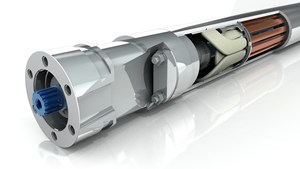BHGE releases field-proven permanent magnet motor
HOUSTON and LONDON -- Baker Hughes, a GE company (BHGE), announced today the introduction of its Magnefficient permanent magnet motor (PMM), which enables operators to increase electrical submersible pumping (ESP) system efficiency, thereby lowering power requirements and overall lifting costs.
Traditional ESP motor energy consumption accounts for up to 30% of ESP system efficiency losses. This is a critical issue in mature fields with declining production rates, where operators are challenged to improve or maintain economics, or areas in which operators are penalized or rewarded based on their power usage. The Magnefficient PMM eliminates induction losses, lowering system power consumption by up to 20% and reducing motor power loss by as much as 67%. With lower idle amps, the PMM allows for better control at lower loads than traditional induction motors.
The motor also delivers a higher power density, which allows operators to use a smaller motor to achieve the same horsepower levels as those achieved with an induction motor. With more power per length, the PMM helps eliminate the need for tandem connections, improving reliability while allowing for faster installations and reducing nonproductive time. This combination of high-energy density and a shorter motor allows the PMM to be placed deeper in slimhole and deviated wellbores, closer to the production zone, to broaden the ESP’s operational flexibility and improve recovery rates through greater reservoir pressure draw down.
On a recent job, an operator in Argentina used the Magnefficient PMM to reduce lifting costs and improve efficiency in a marginal, mature field. During seasonally cold conditions, government regulations required the company to provide natural gas to the local grid for heating, which limited the amount of gas available to generate power to the field. BHGE recommended trialing the Magnefficient PMM to reduce power consumption and to achieve the required 200 horsepower without the need for tandem motor connections. At half the length of the traditional induction motor system, the PMM system was assembled 2.3 times faster. The PMM also increased overall motor efficiency by more than 26% and allowed the operator to achieve a 23% reduction in power costs. This generated energy savings between 15-26%, encouraging the operator to deploy five additional systems in the coming months.



